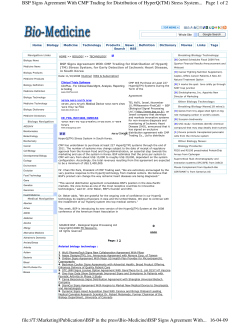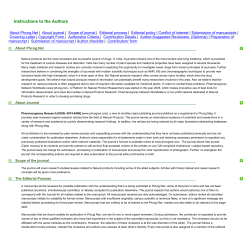
Annual Report 2012 FEBS Letters Editorial Office June 25, 2013
Annual Report 2012 FEBS Letters Editorial Office June 25, 2013 Contents INTRODUCTION ................................................................................................................ 1 QUICK FACTS .................................................................................................................... 1 MANUSCRIPT NUMBERS ................................................................................................... 2 Submissions by region of origin ................................................................................................. 2 Published ................................................................................................................................. 2 HANDLING AND TURNAROUND TIMES .............................................................................. 3 ADDITIONAL EDITORIAL INITIATIVES ................................................................................. 5 Special Issues............................................................................................................................ 5 Focus on… ................................................................................................................................ 6 Young Group Leader Award 2012 .............................................................................................. 6 APPENDIX ......................................................................................................................... 7 Editorial Board ......................................................................................................................... 7 Impact factor ............................................................................................................................ 8 INTRODUCTION FEBS Letters is a world-renowned journal for rapid publication of short reports describing novel and specific effects with a biologically or biochemically significant function. Bringing together the most important developments in the molecular biosciences, FEBS Letters provides an international forum for Research Letters, Reviews and Hypotheses describing or discussing mechanistic insights at the molecular level, which would be interesting to a broad readership. FEBS Letters is the 11th largest journal in the fields of biology, biochemistry, cell biology, molecular biology and biophysics according to Journal Citation Reports®, Thomson Reuters, and is published by Elsevier on behalf of FEBS. QUICK FACTS Impact Factor: 3.538 Immediacy Index: 0.643 Cited Half-Life: >10.0 years Submissions published: 636 Special Issues: 5 (see Special Issues) Editorial Office Felix Wieland, Managing Editor Aleksander Benjak, Editorial Manager Daniela Ruffell, Editor Wilhelm Just, Reviews Editor Anne Rougeaux, Editorial Assistant Academic Editors: 45 (see Appendix: Editorial Board) Publishing Editor: Carl L. Schwarz, Elsevier Journal Manager: Olaf Meesters, Elsevier 1 MANUSCRIPT NUMBERS Submissions by region of origin More than half of all handled manuscripts originated from Asia, with China being the primary country of origin overall (30%). Accordingly, the majority of all accepted manuscripts originate from Asia (41%). (Figure 1). Europe North America Asia South America Australia Africa handled 23% 12% 60% 3% 1% 1% Figure 1. Continental breakdown of handled and accepted manuscripts in 2012. Circles and red numbers show the percentage of total handled manuscripts per continent. Published We published 636 manuscripts in 24 volumes in 2012, out of which 5 were Special Issues. Compared to 2011, this is an increase of 4% of all published manuscripts. Reviews amounted to a total of 21% of all published manuscripts (Figure 2). 2 Research Letters/ Hypothesis Reviews All 2008 598 (91%) 62 (9%) 660 2009 550 (86%) 93 (14%) 643 2010 547 (73%) 200 (27%) 747 2011 483 (79%) 131 (21%) 614 2012 502 (79%) 134 (21%) 636 Figure 2. Number of published manuscripts in the past five years. Columns show the overall number of published manuscripts, which is divided into Research Letters and Hypotheses (green) and Reviews (red), with percentage of total given in brackets. HANDLING AND TURNAROUND TIMES The handling time is calculated as the time from when a manuscript has been assigned to an editor until the time when the first decision has been reached. The overall handling time in 2012 was 16 days. On the other hand, the turnaround time is calculated as the time from when a manuscript has been submitted until the time when the first decision has been reached. The overall turnaround time in 2012 was 16 days (Figure 3). 3 Academic Editors Editorial Office Average handling Average turnaround 2008 23 4 16 17 2009 20 3 15 17 2010 21 3 15 16 2011 21 4 14 16 2012 24 4 16 16 Figure 3. Handling and turnaround times for Academic Editors and Editorial Office in the past five years. Columns show the average handling time (days) for Academic Editors (blue) and Editorial Office (green). The overall average handling time is shown in orange and the overall turnaround time in red. 4 ADDITIONAL EDITORIAL INITIATIVES Special Issues We published the following Special Issues in 2012: Electron/proton coupling in biological energy transduction Sorting the TGF-β Labyrinth Joan Massagué and Wilhelm Just; FEBS Lett. 586(14) (19 Reviews) Miguel Sepúlveda Teixeira and Ricardo O. Louro; FEBS Lett. 586(5) (20 Reviews) Synthetic Biology Modular Protein Domains Thomas Reiss and Wilhelm Just; FEBS Lett. 586(15) (22 Reviews) Marius Sudol, Gianni Cesareni, Giulio Superti-Furga and Wilhelm Just; FEBS Lett. 586(17) (29 Reviews) Seville special issue: From Single Molecules to Systems Biology Miguel De la Rosa, Felix Wieland and Wilhelm Just; FEBS Lett. 586(18) (24 Reviews) 5 Focus on… We published the following Focus on… review series in 2012: Focus on… Ubiquitin-Related Tumor Suppressors (4 Reviews in FEBS Lett. 586(10) and 5 Reviews in FEBS Lett. 586(11)) Young Group Leader Award 2012 The FEBS Letters Young Group Leader Award is given to an independent scientist, aged 40 years or younger, who is the corresponding author of an outstanding research letter published in the previous calendar year. The prize is endowed with €10.000 prize money and is presented on the annual FEBS Congress. The award in 2012 was given to: Dr. Megumi Funakoshi-Tago, Keio University, Japan Sumi K et al. (2011) Aurora kinase A critically contributes to the resistance to anti-cancer drug cisplatin in JAK2 V617F mutant-induced transformed cells. FEBS Lett. 585(12):1884–90. The prize-winning manuscript investigates the mechanisms by which cancer cells survive chemotherapeutic drugs. In particular, the authors address how JAK2, a non-receptor tyrosine kinase often deregulated in hematological malignancies, contributes to chemoresistance. It was previously reported that JAK2 upregulates several transcription factors, including Myc. The group led by Dr. Funakoshi-Tago now shows the critical requirement of Myc-induced Aurora kinase A for the resistance of cells expressing an oncogenic mutant of JAK2 to cisplatin, a commonly used anticancer drug. These results provide insight into the intricate ways tumor cells exploit signalling pathways and suggest that the combination of Aurora kinase inhibitors with chemotherapeutic drugs may be useful to treat myeloproliferative neoplasms. 6 APPENDIX Editorial Board Jesus Avila, Universidad Autónoma, Madrid, Spain Paul Bertone, EMBL European Bioinformatics Institute, Wellcome Trust Genome Campus; Cambridge, UK Peter Brzezinski, Stockholm University, Stockholm, Sweden Michael R. Bubb, University of Florida, Gainesville, FL, USA Giovanni Cesareni, Universitá "Tor Vergata", Rome, Italy Zhijie Chang, Tsinghua University, Beijing, China Amitabha Chattopadhyay, Centre for Cellular & Molecular Biology, Hyderabad, India Quan Chen, Nankai University, Tianjin, China & The State Key Laboratory of Biomembrane and Membrane Biotechnology, Chinese Academy of Sciences, Beijing, China Richard Cogdell, University of Glasgow, Glasgow, United Kingdom Tamas Dalmay, University of East Anglia, Norwich, England Miguel A. De la Rosa, Universidad de Sevilla y CSIC, Sevilla, Spain Stuart Ferguson, University of Oxford, Oxford, United Kingdom Ulf- Ingo Flügge, Universität zu Köln, Cologne, Germany Takashi Gojobori, National Institutes of Genetics, Mishima, Japan Christian Griesinger, Max-Planck-Institut für biophysikalische Chemie, Göttingen, Germany Barry Halliwell, National University of Singapore, Singapore Lukas A. Huber, Universität Innsbruck, Innsbruck, Austria Michael Ibba, Ohio State University, Columbus, OH, USA Beat Imhof, Centre Medical Universitaire, Geneva, Switzerland Kazuhiro Iwai, Kyoto University, Kyoto, Japan Hans- Dieter Klenk, Philipps-Universität Marburg, Marburg, Germany Jacomine Krijnse-Locker, BioQuant, Heidelberg, Germany Ulrike Kutay, Swiss Federal Institute of Technology (ETH), Zurich, Switzerland Veli-Pekka Lehto, University of Helsinki, Helsinki, Finland Kaspar Locher, Institute of Molecular Biology and Biophysics, Zürich, Switzerland Dietmar J. Manstein, Hannover Medical School (MHH), Institute for Biophysical Chemistry, Hannover, Germany Ned Mantei, Swiss Federal Institute of Technology (ETH), Zürich, Switzerland Masayuki Miyasaka, Osaka University, Suita, Japan Noboru Mizushima, Tokyo Medical and Dental University Graduate School, Tokyo, Japan Maurice Montal, University of California San Diego, La Jolla, CA, USA Laszlo Nagy, University of Debrecen Nagyerdei krt. 98., Debrecen, Hungary Angel R. Nebreda, Institute for Research in Biomedicine (IRB Barcelona), Barcelona, Spain Judit Ovádi, Hungarian Academy of Sciences, Budapest, Hungary Francesc Posas, Universitat Pompeu Fabra (UPF), Barcelona, Spain Varda Rotter, Weizmann Institute of Science, Rehovot, Israel Robert B. Russell, BioQuant, Heidelberg, Germany Ivan Sadowski, University of British Columbia, Vancouver, BC, Canada Julian I. Schroeder, University of California San Diego, La Jolla, USA Irmgard Sinning, University of Heidelberg, Heidelberg, Germany Vladimir P Skulachev, Moscow State University, Moscow, Russia 7 Sandro Sonnino, Università degli Studi di Milano, Milan, Italy Bing Sun, Institute of Biochemistry and Cell Biology, Chinese Academy of Sciences, Shanghai, China Michael R. Sussman, University of Wisconsin Biotechnology Center, Madison, WI, USA Renee Tsolis, University of California, Davis, CA, USA Felix Wieland, University of Heidelberg, Heidelberg, Germany Berend Wieringa, NCMLS, UMC Radboud University, Nijmegen, Netherlands Impact factor IF: Research Letters/Hypotheses IF: Reviews Impact factor 2007 2.841 9.348 3.263 2008 2.764 9.530 3.264 2009 2.822 11.311 3.541 2010 2.965 8.400 3.601 2011 2.639 7.874 3.538 Figure 4. Impact factor in the past four years. The columns show the official Impact factor (blue line) and the calculated Impact factor for Research Letters and Hypotheses (red) and Reviews (green). 8
© Copyright 2025





















